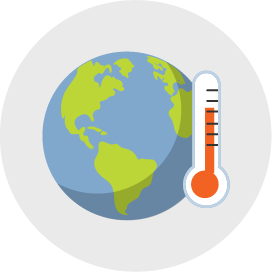Statewide conditions
As the state's lead agency for water supplies, we pay close attention to multiple data sources and monitor them closely. Rain and other precipitation, groundwater (water held in aquifers), rivers and streams, and mountain snow (snowpack) are all important contributors to water supply that we monitor.
What is water supply?
What is WSAC? 
The Water Supply Availability Committee (WSAC) is a group of experts from state and federal agencies who evaluate statewide water supply conditions. Ecology chairs this group that provides an important consultative role to Ecology. WSAC advises Ecology on current and forecasted water supply conditions and whether the hydrologic drought threshold has been met or is likely to be met: seventy-five percent of normal water supply within a geographic area (RCW 43.83B.405 and WAC 173-166-050).
If you would like to receive notices about WSAC meetings after they are posted to this page, subscribe to the Washington Water Supply Email list.
The Water Supply Availability Committee (WSAC) meets on a monthly basis. Presentation materials and recording is now available: Water Supply Availability Committee website.
Data round-up: drought conditions summary
Below is a snapshot of wide variety of data sources that helps Ecology to understand evolving drought conditions. This will be updated monthly.
The Washington State Climate Office - Climate Outlook
- Early August - ENSO-neutral conditions are likely to continue through October according to the Climate Prediction Center (CPC). Neutral conditions make it more difficult to predict upcoming fall conditions. There are roughly equal chances of either La Niña or neutral ENSO conditions for the upcoming winter, with much lower chances of El Niño conditions.
- Last updated: August 11, 2025; Next update (bi-monthly): Late August
- Snowpack continues to be fully melted out from all sites (compared to normal (the 30-year average for today; info:Climate Normals | NOAA or Climatic Normals | NRCS)
- 83% Statewide water year to date precipitation (Down 2% from last week).
- SWE Interactive Map – NWCC iMap or SWE by Basin – PDF (Why does “SWE” matter – USDA Factsheet).
- Last updated: August 25, 2025; Next update (daily): August 26, 2025.
Bureau of Reclamation (BOR)
- Yakima River system (Keechelus, Kachess, Cle Elum, Bumping, Rimrock) is at 24% of capacity and storage is at 47.2% of average (for this time of year).
- Update: On August 7, BOR announced a forecast for August-Sept 30 of 40% for prorated irrigation districts.
- Last updated: August 25, 2025; Next update (storage-daily): August 26, 2025. Next BOR forecast will be Sept 4.
Northwest River Forecast Center data and information updates:
- 10 Day Meteorological Forests – Possible, minor precipitation forecasted in on/off the middle of the next ten-day period, but minimal expected in the central areas of the Eastside. Temperatures to continue to be above 90 in the Eastside and over 100 in the next few days.
- Forecast report and Forecast map – A mix of streamflow mostly in the 50-75% percent of normal for August-September, remaining of the April-September period.
- For April-September the period, the Okanagan River is forecasted at 52% of normal, Methow at 72%, Stehekin at 71%, and Chelan at 69%.
- NOTE: April – Sept forecasts are based on the next 10 days of forecast data, then based on climate Normals from 1991-2020 average.
- Lasted updated: August 25, 2025; Next update(daily): August 26, 2025.
- 8-14 day Outlook: Warmer than normal temperatures expected statewide, more so on the Westside. Leaning towards above normal precipitation statewide, relatively more so on the Eastside.
- Valid: Sept 2 – Sept 8, 2025, Issued: August 25, 2025
- September Monthly Forecast: September predictions lean toward warmer than normal temperatures statewide and lean toward above normal precipitation on the Westside.
- Three month: (September-October-November) - Temperature predictions are equal changes or above or below normal statewide. Precipitation leaning towards slightly above normal.
-
- Last updated: Issued August 21, 2025; Next update (long-range) Sept 18, 2025
National Integrated Drought Information System (NIDIS) Drought monitor
- National Drought Monitor – Portions of 10 counties are in D3- Extreme drought status, with the rest of the state either in D1-Moderate drought or D2-Severe drought. No part of this state is only abnormally dry on this tool.
- Updated: August 21, 2025 (U.S. Drought Monitor map is released every Thursday morning, with data valid through Tuesday at 10am PT).
United States Geological Survey (USGS) - WA Water Science Center:
- National Water Dashboard – A wide range of above normal, normal, below normal, and significantly below normal flows statewide, with a mix in the same parts of the state.
- Last updated: August 25, 2025; Next update (daily): August 26, 2025
Other data tools used and updated:
- Odds of 2024 Water Year Precipitation Reaching 100% - As of August 1, most of the state is at 0-20% odds for reaching 100% of normal precipitation for water year 2025.
- Climate Mapper – Mean Temperature & Precipitation Anomaly - Last 30 days - Higher than normal temperatures mostly statewide; Below normal precipitation statewide.
- PRISM Palmer Drought Severity Index – A range of values across the state on this drought severity index
Related links
Contact information
Caroline Mellor
Statewide Drought Lead
caroline.mellor@ecy.wa.gov
360-628-4666


